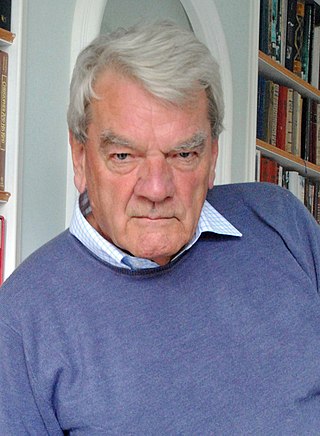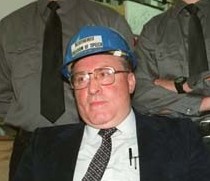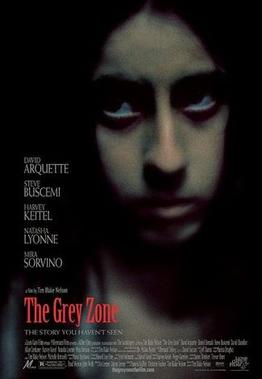
Nazi Germany used six extermination camps, also called death camps, or killing centers, in Central Europe during World War II to systematically murder over 2.7 million people – mostly Jews – in the Holocaust. The victims of death camps were primarily murdered by gassing, either in permanent installations constructed for this specific purpose, or by means of gas vans. The six extermination camps were Chełmno, Belzec, Sobibor, Treblinka, Majdanek and Auschwitz-Birkenau. Extermination through labour was also used at the Auschwitz and Majdanek death camps. Millions were also murdered in concentration camps, in the Aktion T4, or directly on site.
Holocaust denial is an antisemitic conspiracy theory that asserts that the Nazi genocide of Jews, known as the Holocaust, is a myth, fabrication, or exaggeration. Holocaust denial involves making one or more of the following false claims:

Zyklon B was the trade name of a cyanide-based pesticide invented in Germany in the early 1920s. It consists of hydrogen cyanide, as well as a cautionary eye irritant and one of several adsorbents such as diatomaceous earth. The product is notorious for its use by Nazi Germany during the Holocaust to murder approximately 1.1 million people in gas chambers installed at Auschwitz-Birkenau, Majdanek, and other extermination camps.

David John Cawdell Irving is an English author who has written on the military and political history of World War II, and especially Nazi Germany, who was found to be a Holocaust denier in a UK court in 2000 as a result of a failed libel case.

A gas chamber is an apparatus for killing humans or animals with gas, consisting of a sealed chamber into which a poisonous or asphyxiant gas is introduced. Poisonous agents used include hydrogen cyanide and carbon monoxide.

Ernst Christof Friedrich Zündel was a German neo-Nazi publisher and pamphleteer of Holocaust denial literature. He was jailed several times: in Canada for publishing literature "likely to incite hatred against an identifiable group", and on charges of being a threat to national security; in the United States, for overstaying his visa; and in Germany for charges of "inciting racial hatred". He lived in Canada from 1958 to 2000.
Fred Arthur Leuchter Jr. is an American manufacturer of execution equipment and Holocaust denier, best known as the author of the Leuchter report, a pseudoscientific document alleging there were no gas chambers at Auschwitz-Birkenau. Prior to the document's publication, he was contracted by authorities of several U.S. states to improve the designs of instruments for capital punishment. He was charged in Massachusetts with misrepresenting himself to penitentiaries as an engineer, despite having no relevant qualifications. He plea bargained with state prosecutors and received two years' probation. He has also been accused of running a "death row shakedown", where he threatened to testify for the defense in capital cases if he was not given contracts for his services by that state.
Mr. Death or Mr Death may refer to:
The Leuchter report is a pseudoscientific document authored by American execution technician Fred A. Leuchter, who was commissioned by Ernst Zündel to defend him at his trial in Canada for distributing Holocaust denial material. Leuchter compiled the report in 1988 with the intention of investigating the feasibility of mass homicidal gassings at Nazi extermination camps, specifically at Auschwitz. He traveled to the camp, collected multiple pieces of brick from the remains of the crematoria and gas chambers, brought them back to the United States, and submitted them for chemical analysis. At the trial, Leuchter was called upon to defend the report in the capacity of an expert witness; however, during the trial, the court ruled that he had neither the qualifications nor experience to act as such.

The Holocaust—the murder of about six million Jews by Nazi Germany from 1941 to 1945—is the best-documented genocide in history. Although there is no single document which lists all Jewish victims of Nazi persecution, there is conclusive evidence that about six million were murdered. There is also conclusive evidence that Jews were gassed at Auschwitz-Birkenau, the Operation Reinhard extermination camps, and in gas vans, and that there was a systematic plan by the Nazi leadership to murder them.

Did Six Million Really Die? The Truth at Last is a pamphlet that promotes Holocaust denial and other neo-Nazi sentiments, allegedly written by British National Front (NF) member Richard Verrall under the pseudonym Richard E. Harwood and published in 1974 by neo-Nazi propagandist Ernst Zündel, another Holocaust denier and pamphleteer. The NF denied that Verrall was the author in a 1978 edition of World in Action.
Germar Rudolf, also known as Germar Scheerer, is a German chemist and a convicted Holocaust denier.

The Grey Zone is a 2001 American historical drama film written and directed by Tim Blake Nelson and starring David Arquette, Steve Buscemi, Harvey Keitel, Mira Sorvino, and Daniel Benzali. It is based on the book Auschwitz: A Doctor's Eyewitness Account written by Dr. Miklós Nyiszli.
The Holocaust History Project (THHP) is an inactive non-profit corporation based in San Antonio, Texas. Its archived website offers a comprehensive selection of documents, recordings, photographs, and essays regarding the Holocaust, Holocaust denial, and antisemitism. The project became known for its refutations of the Leuchter report and the Rudolf report. Since then, it has assisted the defense in the case of Irving v. Lipstadt. As of 2016, THHP website is no longer available online but all of its contents are accessible via several hundred captures in the Internet Archive. However starting April 2016 the French NGO and project phdn.org has put back online an almost complete copy of the original THHP website.
Thies Christophersen was a prominent German Holocaust denier.

Dariusz Ratajczak was a Polish historian, publicist and right-wing activist. In 1999 he was convicted of Holocaust denial in Poland.

Robert Jan van Pelt is a Dutch author, architectural historian, professor at the University of Waterloo and a Holocaust scholar. One of the world's leading experts on Auschwitz, he regularly speaks on Holocaust related topics, through which he has come to address Holocaust denial. He was an expert witness in Deborah Lipstadt's successful defence in the civil libel suit brought against her by British author and Holocaust denier David Irving in 1996.

Denying the Holocaust: The Growing Assault on Truth and Memory is a 1993 book by the historian Deborah Lipstadt, in which the author discusses the Holocaust denial movement. Lipstadt named British writer David Irving as a Holocaust denier, leading him to sue her unsuccessfully for libel. She gives a detailed explanation of how people came to deny the Holocaust or claim that it was vastly exaggerated by the Jews.
In 2005, the British author and Holocaust denier David Irving was arrested for Holocaust denial in Austria. In early 2006, he was convicted and given a sentence of three years, of which he served 13 months after a reduction of his prison sentence.











